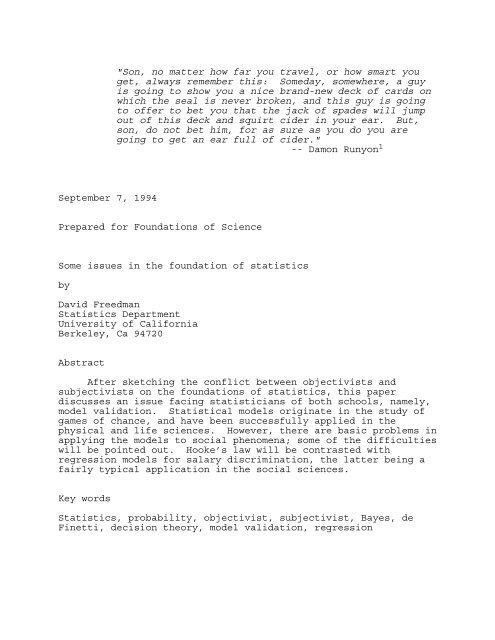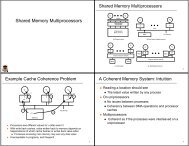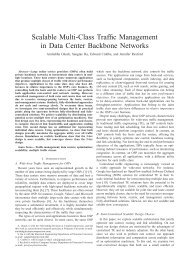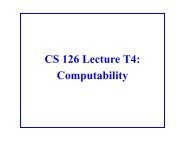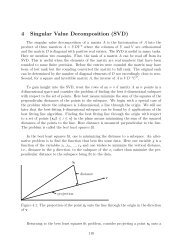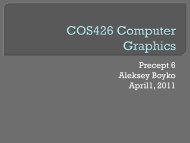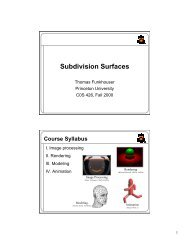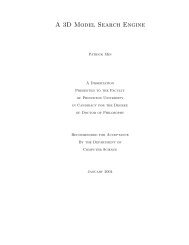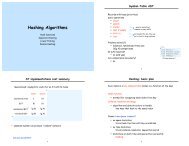"Son, no matter how far you travel, or how smart you get, always ...
"Son, no matter how far you travel, or how smart you get, always ...
"Son, no matter how far you travel, or how smart you get, always ...
Create successful ePaper yourself
Turn your PDF publications into a flip-book with our unique Google optimized e-Paper software.
September 7, 1994<br />
"<strong>Son</strong>, <strong>no</strong> <strong>matter</strong> <strong>how</strong> <strong>far</strong> <strong>you</strong> <strong>travel</strong>, <strong>or</strong> <strong>how</strong> <strong>smart</strong> <strong>you</strong><br />
<strong>get</strong>, <strong>always</strong> remember this: Someday, somewhere, a guy<br />
is going to s<strong>how</strong> <strong>you</strong> a nice brand-new deck of cards on<br />
which the seal is never broken, and this guy is going<br />
to offer to bet <strong>you</strong> that the jack of spades will jump<br />
out of this deck and squirt cider in <strong>you</strong>r ear. But,<br />
son, do <strong>no</strong>t bet him, f<strong>or</strong> as sure as <strong>you</strong> do <strong>you</strong> are<br />
going to <strong>get</strong> an ear full of cider."<br />
-- Damon Runyon 1<br />
Prepared f<strong>or</strong> Foundations of Science<br />
Some issues in the foundation of statistics<br />
by<br />
David Freedman<br />
Statistics Department<br />
University of Calif<strong>or</strong>nia<br />
Berkeley, Ca 94720<br />
Abstract<br />
After sketching the conflict between objectivists and<br />
subjectivists on the foundations of statistics, this paper<br />
discusses an issue facing statisticians of both schools, namely,<br />
model validation. Statistical models <strong>or</strong>iginate in the study of<br />
games of chance, and have been successfully applied in the<br />
physical and life sciences. However, there are basic problems in<br />
applying the models to social phe<strong>no</strong>mena; some of the difficulties<br />
will be pointed out. Hooke’s law will be contrasted with<br />
regression models f<strong>or</strong> salary discrimination, the latter being a<br />
fairly typical application in the social sciences.<br />
Key w<strong>or</strong>ds<br />
Statistics, probability, objectivist, subjectivist, Bayes, de<br />
Finetti, decision the<strong>or</strong>y, model validation, regression
1. What is probability?<br />
F<strong>or</strong> a contemp<strong>or</strong>ary mathematician, probability is easy to<br />
define, as a countably additive set function on a σ-field, with a<br />
total mass of 1. This definition, perhaps cryptic f<strong>or</strong> <strong>no</strong>nmathematicians,<br />
was introduced by A. N. Kolmog<strong>or</strong>ov around 1930,<br />
and has been extremely convenient f<strong>or</strong> mathematical w<strong>or</strong>k;<br />
the<strong>or</strong>ems can be stated with clarity, and proved with rig<strong>or</strong>. 2<br />
F<strong>or</strong> applied w<strong>or</strong>kers, the definition is less useful;<br />
countable additivity and σ-fields are <strong>no</strong>t observed in nature.<br />
The issue is of a familiar type-- What objects in the w<strong>or</strong>ld<br />
c<strong>or</strong>respond to probabilities? This question divides statisticians<br />
into two camps:<br />
(i) the "objectivist" school, also called the<br />
"frequentists";<br />
(ii) the "subjectivist" school, also called the "Bayesians,"<br />
after the Reverend Thomas Bayes (England, c.1701-1761).<br />
Other positions have <strong>no</strong>w largely fallen into disfav<strong>or</strong>; f<strong>or</strong><br />
example, there were "fiducial" probabilities introduced by R. A.<br />
Fisher (England, 1890-1962). Fisher was one of the two great<br />
statisticians of the century; the other, Jerzy Neyman (b. Russia,<br />
1894; d. U.S.A. 1981), turned to objectivism after a Bayesian<br />
start. Indeed, the objectivist position <strong>no</strong>w seems to be the<br />
dominant one in the field, although the subjectivists are still a<br />
strong presence. Of course, the names are imperfect descript<strong>or</strong>s.<br />
Furtherm<strong>or</strong>e, statisticians agree amongst themselves about as well<br />
as philosophers; many shades of opinion will be represented in<br />
each school.<br />
2
2. The objectivist position<br />
Objectivists hold that probabilities are inherent properties<br />
of the systems being studied. F<strong>or</strong> a simple example, like the<br />
toss of a coin, the idea seems quite clear at first. You toss<br />
the coin, it will land heads <strong>or</strong> tails, and the probability of<br />
heads is around 50%. A m<strong>or</strong>e exact value can be determined<br />
experimentally, by tossing the coin repeatedly and taking the<br />
long run relative frequency of heads. In one such experiment,<br />
John Kerrich (a South African mathematician interned by the<br />
Germans during W<strong>or</strong>ld War II) tossed a coin 10,000 times and got<br />
5,067 heads: the relative frequency was 5,067/10,000 = 50.67%.<br />
F<strong>or</strong> an objectivist such as myself, the probability of Kerrich’s<br />
coin landing heads has its own existence, separate from the data;<br />
the latter enable us to estimate the probability, <strong>or</strong> test<br />
hypothesis concerning it.<br />
The objectivist position exposes one to certain famous<br />
difficulties. As Keynes said, In the long run, we are all dead.<br />
Heraclitus’ epigram (also out of context) is even m<strong>or</strong>e severe:<br />
You can’t step into the same river twice. Still, the tosses of a<br />
coin, like the throws of a die and the results of other such<br />
chance processes, do exhibit remarkable statistical regularities.<br />
These regularities can be described, predicted, analyzed by<br />
technical probability the<strong>or</strong>y. Using Kolmog<strong>or</strong>ov’s axioms (<strong>or</strong> m<strong>or</strong>e<br />
primitive definitions), we can construct statistical models that<br />
c<strong>or</strong>respond to empirical phe<strong>no</strong>mena; although verification of the<br />
c<strong>or</strong>respondence is <strong>no</strong>t the easiest of tasks.<br />
3
3. The subjectivist position<br />
F<strong>or</strong> the subjectivist, probabilities describe "degrees of<br />
belief." There are two camps within the subjectivist school, the<br />
"classical" and the "radical." F<strong>or</strong> a "classical" subjectivist,<br />
like Bayes himself <strong>or</strong> Laplace-- although such hist<strong>or</strong>ical readings<br />
are quite tricky-- there are objective "parameters" which are<br />
unk<strong>no</strong>wn and to be estimated from the data. (A parameter is a<br />
numerical characteristic of a statistical model f<strong>or</strong> data-- f<strong>or</strong><br />
instance, the probability of a coin landing heads; other examples<br />
will be given below.) Even bef<strong>or</strong>e data collection, the classical<br />
subjectivist has inf<strong>or</strong>mation about the parameters, expressed in<br />
the f<strong>or</strong>m of a "pri<strong>or</strong> probability distribution."<br />
The crucial distinction between a classical subjectivist and<br />
an objectivist: the f<strong>or</strong>mer will make probability statements<br />
about parameters-- f<strong>or</strong> example, in a certain coin-tossing<br />
experiment, there is a 25% chance that the probability of heads<br />
exceeds .67. However, objectivists usually do <strong>no</strong>t find that such<br />
statements are meaningful; they view the probability of heads as<br />
an unk<strong>no</strong>wn constant, which either is-- <strong>or</strong> is <strong>no</strong>t-- bigger than<br />
.67. In replications of the experiment, the probability of heads<br />
will <strong>always</strong> exceed .67, <strong>or</strong> never; 25% can<strong>no</strong>t be relevant. As a<br />
technical <strong>matter</strong>, if the parameter has a probability distribution<br />
given the data, it must have a "marginal" distribution-- that is,<br />
a pri<strong>or</strong>. On this point, objectivists and subjectivists agree;<br />
the hold-out was R. A. Fisher, whose fiducial probabilities come<br />
into existence only after data collection.<br />
"Radical" subjectivists, like Bru<strong>no</strong> de Finetti <strong>or</strong> Jimmie<br />
Savage, differ from classical subjectivists and objectivists;<br />
radical subjectivists deny the very existence of unk<strong>no</strong>wn<br />
parameters. F<strong>or</strong> such statisticians, probabilities express<br />
degrees of belief about observables. You pull a coin out of<br />
<strong>you</strong>r pocket, and-- Damon Runyon <strong>no</strong>twithstanding-- they can assign<br />
a probability to the event that it will land heads when <strong>you</strong> toss<br />
it. The braver ones can even assign a probability to the event<br />
that <strong>you</strong> really will toss the coin. (These are "pri<strong>or</strong>"<br />
probabilities, <strong>or</strong> "opinions.") Subjectivists can also "update"<br />
opinions in the light of the data; f<strong>or</strong> example, if the coin is<br />
tossed 10 times, landing heads 6 times and tails 4 times, what is<br />
the chance that it will land heads on the 11th toss? This<br />
involves computing a "conditional" probability using Kolmog<strong>or</strong>ov’s<br />
calculus, which applies whether the probabilities are subjective<br />
<strong>or</strong> objective.<br />
4
Here is an example with a different flav<strong>or</strong>: What is the<br />
chance that a republican will be president of the U.S. in the<br />
year 2025? F<strong>or</strong> many subjectivists, this is a meaningful<br />
question, which can in principle be answered by introspection.<br />
F<strong>or</strong> many objectivists, this question is beyond the scope of<br />
statistical the<strong>or</strong>y. As best I can judge, <strong>how</strong>ever, complications<br />
will be found on both sides of the divide. Some subjectivists<br />
will <strong>no</strong>t have quantifiable opinions about remote political<br />
events; likewise, there are objectivists who might develop<br />
statistical models f<strong>or</strong> presidential elections, and compute<br />
probabilities on that basis. 3<br />
The difference between the radical and classical<br />
subjectivists rides on the distinction between parameters and<br />
observables; this distinction is made by objectivists too and is<br />
often quite helpful. (In some cases, of course, the issue may be<br />
rather subtle.) The radical subjectivist denial of parameters<br />
exposes them to certain rhet<strong>or</strong>ical awkwardness; f<strong>or</strong> example, they<br />
are required <strong>no</strong>t to understand the idea of a tossing a coin with<br />
an unk<strong>no</strong>wn probability of heads. Indeed, if they admit the coin,<br />
they will soon be stuck with all the unk<strong>no</strong>wn parameters that were<br />
previously banished. 4<br />
5
Probability and relative frequency<br />
In <strong>or</strong>dinary language, "probabilities" are <strong>no</strong>t distinguished<br />
at all sharply from empirical percentages-- "relative<br />
frequencies." In statistics, the distinction may be m<strong>or</strong>e<br />
critical. With Kerrich’s coin, the relative frequency of heads<br />
in 10,000 tosses, 50.67%, is unlikely to be the exact probability<br />
of heads; but it is unlikely to be very <strong>far</strong> off. F<strong>or</strong> an example<br />
with a different texture, suppose <strong>you</strong> see the following sequence<br />
of 10 heads and 10 tails:<br />
T H T H T H T H T H T H T H T H T H T H.<br />
What is the probability that the next observation will be a head?<br />
In this case, relative frequency and probability are quite<br />
different. 5<br />
One m<strong>or</strong>e illustration along that line: United Airlines<br />
flight 140 operates daily from San Francisco to Philadelphia. In<br />
192 out of the last 365 days, flight 140 landed on time. You are<br />
going to take this flight tom<strong>or</strong>row. Is <strong>you</strong>r probability of<br />
landing on time given by 192/365? F<strong>or</strong> a radical subjectivist,<br />
the question is clear; <strong>no</strong>t so f<strong>or</strong> an objectivist <strong>or</strong> a classical<br />
subjectivist. Whatever the question really means, 192/365 is the<br />
wrong answer-- if <strong>you</strong> are flying on the Friday bef<strong>or</strong>e Christmas.<br />
This is Fisher’s "relevant subset" issue; and he seems to have<br />
been anticipated by von Mises. Of course, if <strong>you</strong> pick a day at<br />
random from the data set, the chance of <strong>get</strong>ting one with an ontime<br />
landing is indeed 192/365; that would <strong>no</strong>t be controversial.<br />
The difficulties come with (i) extrapolation and (ii) judging the<br />
exchangeability of the data, in a useful Bayesian phrase.<br />
Probability is a subtler idea than relative frequency. 6<br />
Labels do <strong>no</strong>t settle the issue<br />
Objectivists sometimes argue that they have the advantage,<br />
because science is objective. This is <strong>no</strong>t serious; "objectivist"<br />
statistical analysis must often rely on judgment and experience:<br />
subjective elements come in. Likewise, subjectivists may tell<br />
<strong>you</strong> that (i) objectivists use "pri<strong>or</strong> inf<strong>or</strong>mation" and (ii) are<br />
theref<strong>or</strong>e closet Bayesians. Point (i) may be granted. The issue<br />
f<strong>or</strong> (ii) is <strong>how</strong> pri<strong>or</strong> inf<strong>or</strong>mation enters the analysis, and<br />
whether this inf<strong>or</strong>mation can be quantified <strong>or</strong> updated the way<br />
subjectivists insist it must be. The real questions are <strong>no</strong>t to<br />
be settled on the basis of labels.<br />
6
4. A critique of the subjectivist position<br />
The subjectivist position seems to be internally consistent,<br />
and fairly immune to logical attack from the outside. Perhaps as<br />
a result, scholars of that school have been quite ener<strong>get</strong>ic in<br />
pointing out the flaws in the objectivist position. From an<br />
applied perspective, <strong>how</strong>ever, the subjectivist position is <strong>no</strong>t<br />
free of difficulties. What are subjective degrees of belief,<br />
where do they come from, and why can they be quantified? No<br />
convincing answers have been produced. At a m<strong>or</strong>e practical<br />
level, a Bayesian’s opinion may be of great interest to himself,<br />
and he is surely free to develop it in any way that pleases him;<br />
but why should the results carry any weight f<strong>or</strong> others?<br />
To answer the last question, Bayesians often cite the<strong>or</strong>ems<br />
s<strong>how</strong>ing "inter-subjective agreement:" under certain<br />
circumstances, as m<strong>or</strong>e and m<strong>or</strong>e data become available, two<br />
Bayesians will come to agree: the data swamp the pri<strong>or</strong>. Of<br />
course, other the<strong>or</strong>ems s<strong>how</strong> that the pri<strong>or</strong> swamps the data, even<br />
when the size of the data set grows without bounds-- particularly<br />
in complex, high-dimensional situations. (F<strong>or</strong> a review, see<br />
Diaconis and Freedman, 1986.) The<strong>or</strong>ems do <strong>no</strong>t settle the issue,<br />
especially f<strong>or</strong> those who are <strong>no</strong>t Bayesians to start with.<br />
My own experience suggests that neither decision-makers <strong>no</strong>r<br />
their statisticians do in fact have pri<strong>or</strong> probabilities. A large<br />
part of Bayesian statistics is about what <strong>you</strong> would do if <strong>you</strong> had<br />
a pri<strong>or</strong>. 7 F<strong>or</strong> the rest, statisticians make up pri<strong>or</strong>s that are<br />
mathematically convenient <strong>or</strong> attractive. Once used, pri<strong>or</strong>s<br />
become familiar; theref<strong>or</strong>e, they come to be accepted as "natural"<br />
and are liable to be used again; such pri<strong>or</strong>s may eventually<br />
generate their own technical literature.<br />
7
Other arguments f<strong>or</strong> the Bayesian position<br />
Coherence. There are well-k<strong>no</strong>wn the<strong>or</strong>ems, including one by<br />
(Freedman & Purves, 1969), s<strong>how</strong>ing that stubb<strong>or</strong>n <strong>no</strong>n-Bayesian<br />
behavi<strong>or</strong> has costs. They can make a "dutch book," and extract<br />
<strong>you</strong>r last penny-- if <strong>you</strong> are generous e<strong>no</strong>ugh to cover all the<br />
bets needed to prove the results. 8 However, most of us don’t bet<br />
at all; even the professionals bet on relatively few events.<br />
Thus, coherence has little practical relevance. (Its rhet<strong>or</strong>ical<br />
power is undeniable-- who wants to be incoherent?)<br />
Rationality. It is often urged that to be rational is to be<br />
Bayesian. Indeed, there are elab<strong>or</strong>ate axiom systems about<br />
preference <strong>or</strong>derings, acts, consequences, and states of nature,<br />
whose conclusion is-- that <strong>you</strong> are a Bayesian. The empirical<br />
evidence s<strong>how</strong>s, fairly clearly, that those axioms do <strong>no</strong>t describe<br />
human behavi<strong>or</strong> at all well. The the<strong>or</strong>y is <strong>no</strong>t descriptive;<br />
people do <strong>no</strong>t have stable, coherent pri<strong>or</strong> probabilities.<br />
Now the argument shifts to the "<strong>no</strong>rmative:" if <strong>you</strong> were<br />
rational, <strong>you</strong> would obey the axioms, and be a Bayesian. This,<br />
<strong>how</strong>ever, assumes what must be proved. Why would a rational<br />
person obey those axioms? The axioms represent decision problems<br />
in schematic and highly stylized ways. Theref<strong>or</strong>e, as I see it,<br />
the the<strong>or</strong>y addresses only limited aspects of rationality. Some<br />
Bayesians have tried to win this argument on the cheap: to be<br />
rational is, by definition, to obey their axioms. (Objectivists<br />
do <strong>no</strong>t <strong>always</strong> stay on the rhet<strong>or</strong>ical high road either.)<br />
Detailed examination of the flaws in the <strong>no</strong>rmative argument<br />
is a complicated task, beyond the scope of the present article.<br />
In brief, my position is this. Many of the axioms, on their own,<br />
have considerable <strong>no</strong>rmative f<strong>or</strong>ce. F<strong>or</strong> example, if I am found to<br />
be in violation of the "sure thing principle," I would probably<br />
reconsider. 9 On the other hand, taken as a whole, decision<br />
the<strong>or</strong>y seems to have about the same connection to real decisions<br />
as war games played on a table do to real wars.<br />
What are the main complications? F<strong>or</strong> some events, I may<br />
have a rough idea of likelihood: one event is very likely,<br />
a<strong>no</strong>ther is unlikely, a third is uncertain. However, I may <strong>no</strong>t be<br />
able to quantify these likelihoods, even to one <strong>or</strong> two decimal<br />
places; and there will be many events whose probabilities are<br />
simply unk<strong>no</strong>wn-- even if definable. 10 Likewise, there are some<br />
benefits that can be assessed with reasonable accuracy; others<br />
can be estimated only to rough <strong>or</strong>ders of magnitude; in some<br />
cases, quantification may <strong>no</strong>t be possible at all. Thus,<br />
utilities may be just as problematic as pri<strong>or</strong>s.<br />
8
The the<strong>or</strong>ems that derive probabilities and utilities from<br />
axioms push the difficulties back one step. 11 In real examples,<br />
the existence of many states of nature must remain unsuspected.<br />
Only some acts can be contemplated; others are <strong>no</strong>t imaginable<br />
until the moment of truth arrives. Of the acts that can be<br />
imagined, the decision-maker will have preferences between some<br />
pairs but <strong>no</strong>t others. Too, common k<strong>no</strong>wledge suggests that<br />
consequences are often quite different in the f<strong>or</strong>eseeing and in<br />
the experiencing.<br />
Intransitivity would be an argument f<strong>or</strong> revision, although<br />
<strong>no</strong>t a decisive one; f<strong>or</strong> example, a person choosing among several<br />
job offers might well have intransitive preferences, which it<br />
would be a mistake to ig<strong>no</strong>re. By way of contrast, an arbitrageur<br />
who trades bonds intransitively is likely to lose a lot of money.<br />
(There is an active market in bonds, while the market in job<br />
offers-- largely <strong>no</strong>n-transferable-- must be rather thin; the<br />
practical details make a difference.) The axioms do <strong>no</strong>t capture<br />
the texture of real decision making. Theref<strong>or</strong>e, the the<strong>or</strong>y has<br />
little <strong>no</strong>rmative f<strong>or</strong>ce.<br />
The fallback defense. Some Bayesians will concede much of what I<br />
have said: the axioms are <strong>no</strong>t binding; rational decision-makers<br />
may have neither pri<strong>or</strong>s <strong>no</strong>r utilities. Still, the following<br />
s<strong>or</strong>ts of arguments can be heard. The decision-maker must have<br />
some ideas about relative likelihoods f<strong>or</strong> a few events; a pri<strong>or</strong><br />
probability can be made up to capture such intuitions, at least<br />
in gross outline. The details (f<strong>or</strong> instance, that distributions<br />
are <strong>no</strong>rmal) can be chosen on the basis of convenience. A utility<br />
function can be put to<strong>get</strong>her using similar logic: the<br />
decision-maker must perceive some consequences as very good, and<br />
big utility numbers can be assigned to these; he must perceive<br />
some other consequences as trivial, and small utilities can be<br />
assigned to those; in between is in between. The Bayesian engine<br />
can <strong>no</strong>w be put to w<strong>or</strong>k, using such approximate pri<strong>or</strong>s and<br />
utilities. Even with these fairly crude approximations, Bayesian<br />
analysis is held to dominate other f<strong>or</strong>ms of inference: that is<br />
the fallback defense.<br />
9
Here is my reaction to such arguments. Approximate Bayesian<br />
analysis may in principle be useful. That this mode of analysis<br />
dominates other f<strong>or</strong>ms of inference, <strong>how</strong>ever, seems quite<br />
debatable. In a statistical decision problem, where the model<br />
and loss function are given, Bayes procedures are often hard to<br />
beat, as are objectivist likelihood procedures; with many of the<br />
familiar textbook models, objectivist and subjectivist procedures<br />
should give similar results if the data set is large. There are<br />
sharp mathematical the<strong>or</strong>ems to back up such statements. 12 On the<br />
other hand, in real problems-- where models and loss functions<br />
are mere approximations-- the optimality of Bayes procedures<br />
can<strong>no</strong>t be a mathematical proposition. And empirical proof is<br />
conspicuously absent.<br />
If we could quantify breakdowns in model assumptions, <strong>or</strong><br />
degrees of err<strong>or</strong> in approximate pri<strong>or</strong>s and loss functions, the<br />
balance of argument might shift considerably. The rhet<strong>or</strong>ic of<br />
"robustness" may suggest that such err<strong>or</strong> analyses are routine.<br />
This is hardly the case even f<strong>or</strong> the models. F<strong>or</strong> pri<strong>or</strong>s and<br />
utilities, the position is even w<strong>or</strong>se, since the entities being<br />
approximated do <strong>no</strong>t have any independent existence-- outside the<br />
Bayesian framew<strong>or</strong>k that has been imposed on the problem.<br />
de Finetti’s the<strong>or</strong>em. Suppose <strong>you</strong> are a radical subjectivist,<br />
watching a sequence of 0’s and 1’s. In <strong>you</strong>r pri<strong>or</strong> opinion, this<br />
sequence is exchangeable: permuting the <strong>or</strong>der of the variables<br />
will <strong>no</strong>t change <strong>you</strong>r opinion about them. A beautiful the<strong>or</strong>em of<br />
de Finetti’s asserts that <strong>you</strong>r opinion can be represented as coin<br />
tossing, the probability of heads being selected at random from a<br />
suitable pri<strong>or</strong> distribution. This the<strong>or</strong>em is often said to<br />
"explain" subjective <strong>or</strong> objective probabilities, <strong>or</strong> justify one<br />
system in terms of the other. 13<br />
Such claims can<strong>no</strong>t be right. What the the<strong>or</strong>em does is<br />
this: it enables the subjectivist to discover features of his<br />
pri<strong>or</strong> by mathematical proof, rather than introspection. F<strong>or</strong><br />
example, suppose <strong>you</strong> have an exchangeable pri<strong>or</strong> about those 0’s<br />
and 1’s. Bef<strong>or</strong>e data collection starts, de Finetti will prove to<br />
<strong>you</strong> by pure mathematics that in <strong>you</strong>r own opinion the relative<br />
frequency of 1’s among the first n observations will almost<br />
surely converge to a limit as n→∞. (Of course, the the<strong>or</strong>em has<br />
other consequences too, but all have the same logical texture.)<br />
10
This <strong>no</strong>tion of "almost surely," and the limiting relative<br />
frequency, are features of <strong>you</strong>r opinion <strong>no</strong>t of any external<br />
reality. ("Almost surely" means with probability 1, and the<br />
probability in question is <strong>you</strong>r pri<strong>or</strong>.) Indeed, if <strong>you</strong> had <strong>no</strong>t<br />
<strong>no</strong>ticed these consequences of <strong>you</strong>r pri<strong>or</strong> by introspection, and<br />
<strong>no</strong>w do <strong>no</strong>t like them, <strong>you</strong> are free to revise <strong>you</strong>r opinion-- which<br />
will have <strong>no</strong> impact outside <strong>you</strong>r head. What the the<strong>or</strong>em does is<br />
to s<strong>how</strong> <strong>how</strong> various aspects of <strong>you</strong>r pri<strong>or</strong> opinion are related to<br />
each other. That is all the the<strong>or</strong>em can do, because the<br />
conditions of the the<strong>or</strong>em are conditions on the pri<strong>or</strong> alone.<br />
To illustrate the difficulty, I cite an old friend rather<br />
than a new enemy. Acc<strong>or</strong>ding to Jeffrey (1983, p.199), de<br />
Finetti’s result proves "<strong>you</strong>r subjective probability measure [is]<br />
a certain mixture <strong>or</strong> weighted average of the various possible<br />
objective probability measures"-- an unusually clear statement of<br />
the interpretation that I deny. Each of Jeffrey’s "objective"<br />
probability measures governs the tosses of a p-coin, where p is<br />
<strong>you</strong>r limiting relative frequency of 1’s. (Of course, p has a<br />
probability distribution of its own, in <strong>you</strong>r opinion.) Thus, p is<br />
a feature of <strong>you</strong>r opinion, <strong>no</strong>t of the real w<strong>or</strong>ld: the mixands in<br />
de Finetti’s the<strong>or</strong>em are "objective" only by termi<strong>no</strong>logical<br />
courtesy. In sh<strong>or</strong>t, the "p-coins" that come out of de Finetti’s<br />
the<strong>or</strong>em are just as subjective as the pri<strong>or</strong> that went in.<br />
To sum up. The the<strong>or</strong>y-- as developed by Ramsey, von Neumann and<br />
M<strong>or</strong>genstern, de Finetti, and Savage, among others-- is great<br />
w<strong>or</strong>k. They solved an imp<strong>or</strong>tant hist<strong>or</strong>ical problem, of interest<br />
to eco<strong>no</strong>mists, mathematicians, statisticians, and philosophers<br />
alike. On a m<strong>or</strong>e practical level, the language of subjective<br />
probability is evocative; some investigat<strong>or</strong>s find the consistency<br />
of Bayesian statistics to be a useful discipline; f<strong>or</strong> some<br />
(including me), the Bayesian approach can suggest statistical<br />
procedures whose behavi<strong>or</strong> is w<strong>or</strong>th investigating. But the the<strong>or</strong>y<br />
is <strong>no</strong>t a complete account of rationality, <strong>or</strong> even close. N<strong>or</strong> is<br />
it the prescribed solution f<strong>or</strong> any large number of problems in<br />
applied statistics, at least as I see <strong>matter</strong>s.<br />
11
5. Statistical models<br />
Of course, statistical models are applied <strong>no</strong>t only to coin<br />
tossing but also to m<strong>or</strong>e complex systems. F<strong>or</strong> example,<br />
"regression models" are widely used in the social sciences, as<br />
indicated below; such applications raise serious epistemological<br />
questions. (This idea will be developed from an objectivist<br />
perspective, but similar issues are felt in the other camp.)<br />
The problem is <strong>no</strong>t purely academic. The census suffers an<br />
undercount, m<strong>or</strong>e severe in some places than others; if certain<br />
statistical models are to be believed, the undercount can be<br />
c<strong>or</strong>rected-- moving seats in Congress and millions of dollars a<br />
year in entitlement funds (Survey Methodology, vol. 18, <strong>no</strong>. 1,<br />
1992; Jurimetrics, vol. 34, <strong>no</strong>. 1, 1993; Statistical Science,<br />
vol. 9, <strong>no</strong>. 4, 1994). If yet other statistical models are to be<br />
believed, the veil of secrecy can be lifted from the ballot box,<br />
enabling the experts to determine <strong>how</strong> racial <strong>or</strong> ethnic groups<br />
have voted-- a crucial step in litigation to enf<strong>or</strong>ce mi<strong>no</strong>rity<br />
voting rights (Evaluation Review, vol. 15, <strong>no</strong>. 6, 1991; Klein and<br />
Freedman, 1993).<br />
Here, I begin with a (relatively) <strong>no</strong>n-controversial example<br />
from physics-- Hooke’s law: strain is prop<strong>or</strong>tional to stress.<br />
(This law is named after Robert Hooke, England, 1653-1703.) We<br />
will have some number n of observations. F<strong>or</strong> the ith<br />
observation, indicated by the subscript i, we hang weight i on a<br />
spring. The length of the spring is measured as length i . The<br />
regression model says that (f<strong>or</strong> quite a large range of<br />
weights 14 ),<br />
(1) length i = a + b × weight i + ε i .<br />
The "err<strong>or</strong>" term ε i is needed because measured length will <strong>no</strong>t be<br />
exactly equal to a + b × weight. If <strong>no</strong>thing else, measurement<br />
err<strong>or</strong> must be reckoned with. We model ε i as a sequence of draws,<br />
made at random with replacement from a box of tickets; each<br />
ticket s<strong>how</strong>s a potential err<strong>or</strong>-- the ε i that will be realized if<br />
that ticket is the ith one drawn. The average of all the<br />
potential err<strong>or</strong>s in the box is assumed to be 0. In m<strong>or</strong>e standard<br />
termi<strong>no</strong>logy, the ε i are assumed to be "independent and<br />
identically distributed, with mean 0." Such assumptions can<br />
present difficult scientific issues, because err<strong>or</strong> terms are <strong>no</strong>t<br />
observable.<br />
12
In equation (1), a and b are parameters, unk<strong>no</strong>wn constants<br />
of nature that characterize the spring: a is the length of the<br />
spring under <strong>no</strong> load, and b is stretchiness-- the increase in<br />
length per unit increase in weight. These parameters are <strong>no</strong>t<br />
observable, but they can be estimated by "the method of least<br />
squares," developed by Adrien-Marie Legendre (France, 1752-1833)<br />
and Carl Friedrich Gauss (Germany, 1777-1855) to fit astro<strong>no</strong>mical<br />
<strong>or</strong>bits. Basically, <strong>you</strong> choose the values of â and b^ to minimize<br />
the sum of the squared "prediction err<strong>or</strong>s", ∑ i e i 2 , where ei is<br />
the prediction err<strong>or</strong> f<strong>or</strong> the ith observation: 15<br />
(2) e i = length i - â - b^ × weight i .<br />
These prediction err<strong>or</strong>s are often called "residuals:" they<br />
measure the difference between the actual length and the<br />
predicted length, the latter being â + b^ × weight.<br />
No one really imagines there to be a box of tickets hidden<br />
in the spring. However, the variability of physical measurements<br />
(under many but by <strong>no</strong> means all circumstances) does seem to be<br />
remarkably like the variability in draws from a box. This is<br />
Gauss’ model f<strong>or</strong> measurement err<strong>or</strong>. In sh<strong>or</strong>t, statistical models<br />
can be constructed that c<strong>or</strong>respond rather closely to empirical<br />
phe<strong>no</strong>mena.<br />
I turn <strong>no</strong>w to social-science applications. A case study<br />
would take us too <strong>far</strong> afield, but a stylized example-- regression<br />
analysis used to demonstrate sex discrimination in salaries,<br />
adapted from (Kaye and Freedman, 1994)-- may give the idea. We<br />
use a regression model to predict salaries (dollars per year) of<br />
employees in a firm from:<br />
·education (years of schooling completed),<br />
·experience (years with the firm),<br />
·the dummy variable "man," which takes the value 1 f<strong>or</strong> men<br />
and 0 f<strong>or</strong> women.<br />
Employees are indexed by the subscript i; f<strong>or</strong> example, salary i is<br />
the salary of the ith employee.<br />
13
The equation is 16<br />
(3) salary i = a + b × education i + c × experience i + d × man i + ε i .<br />
Equation (3) is a statistical model f<strong>or</strong> the data, with unk<strong>no</strong>wn<br />
parameters a, b, c, d; here, a is the "intercept" and the others<br />
are "regression coefficients"; ε i is an u<strong>no</strong>bservable err<strong>or</strong> term.<br />
This is a f<strong>or</strong>mal analog of Hooke’s law (1); the same assumptions<br />
are made about the err<strong>or</strong>s. In other w<strong>or</strong>ds, an employee’s salary<br />
is determined as if by computing<br />
(4) a + b × education + c × experience + d × man,<br />
then adding an err<strong>or</strong> drawn at random from a box of tickets. The<br />
display (4) is the expected value f<strong>or</strong> salary given the<br />
explanat<strong>or</strong>y variables (education, experience, man); the err<strong>or</strong><br />
term in (3) represents deviations from the expected.<br />
The parameters in (3) are estimated from the data using<br />
least squares. If the estimated coefficient d f<strong>or</strong> the dummy<br />
variable turns out to be positive and "statistically significant"<br />
(by a "t-test"), that would be taken as evidence of disparate<br />
impact: men earn m<strong>or</strong>e than women, even after adjusting f<strong>or</strong><br />
differences in background fact<strong>or</strong>s that might affect productivity.<br />
Education and experience are entered into equation (3) as<br />
"statistical controls," precisely in <strong>or</strong>der to claim that<br />
adjustment has been made f<strong>or</strong> differences in backgrounds.<br />
Suppose the estimated equation turns out as follows:<br />
(5) predicted salary = $7,100 + $1,300 × education +<br />
$2,200 × experience + $700 × man.<br />
That is, â = $7,100, b^ = $1,300, and so f<strong>or</strong>th. Acc<strong>or</strong>ding to<br />
equation (5), every extra year of education is w<strong>or</strong>th on average<br />
$1,300; similarly, every extra year of experience is w<strong>or</strong>th on<br />
average $2,200; and, most imp<strong>or</strong>tant, men <strong>get</strong> an premium of $700<br />
over women with the same education and experience, on average.<br />
A numerical example will illustrate (5). A male employee<br />
with 12 years of education (high school) and 10 years of<br />
experience would have a predicted salary of<br />
(6) $7,100 + $1,300 × 12 + $2,200 × 10 + $700 × 1 =<br />
$7,100 + $15,600 + $22,000 + $700 = $45,400.<br />
14
A similarly situated female employee has a predicted salary of<br />
only<br />
(7) $7,100 + $1,300 × 12 + $2,200 × 10 + $700 × 0 =<br />
$7,100 + $15,600 + $22,000 + $0 = $44,700.<br />
Notice the impact of the dummy variable: $700 is added to (6),<br />
but <strong>no</strong>t to (7).<br />
A maj<strong>or</strong> step in the argument is establishing that the<br />
estimated coefficient d^ of the dummy variable in (3) is<br />
"statistically significant." This step turns out to depend on<br />
the statistical assumptions built into the model. F<strong>or</strong> instance,<br />
each extra year of education is assumed to be w<strong>or</strong>th the same (on<br />
average) across all levels of experience, both f<strong>or</strong> men and women.<br />
Similarly, each extra year of experience is w<strong>or</strong>th the same across<br />
all levels of education, both f<strong>or</strong> men and women. Furtherm<strong>or</strong>e,<br />
the premium paid to men does <strong>no</strong>t depend systematically on<br />
education <strong>or</strong> experience. Ability, quality of education, <strong>or</strong><br />
quality of experience are assumed <strong>no</strong>t to make any systematic<br />
difference to the predictions of the model.<br />
The st<strong>or</strong>y about the err<strong>or</strong> term-- that the ε’s are<br />
independent and identically distributed from person to person in<br />
the data set-- turns out to be critical f<strong>or</strong> computing statistical<br />
significance. Discrimination can<strong>no</strong>t be proved by regression<br />
modeling unless statistical significance can be established, and<br />
statistical significance can<strong>no</strong>t be established unless<br />
conventional presuppositions are made about u<strong>no</strong>bservable err<strong>or</strong><br />
terms.<br />
Lurking behind the typical regression model will be found a<br />
host of such assumptions; without them, legitimate inferences<br />
can<strong>no</strong>t be drawn from the model. There are statistical procedures<br />
f<strong>or</strong> testing some of these assumptions. However, the tests often<br />
lack the power to detect substantial failures. Furtherm<strong>or</strong>e,<br />
model testing may become circular; breakdowns in assumptions are<br />
detected, and the model is redefined to accommodate. In sh<strong>or</strong>t,<br />
hiding the problems can become a maj<strong>or</strong> goal of model building.<br />
15
Using models to make predictions of the future, <strong>or</strong> the<br />
results of interventions, would be a valuable c<strong>or</strong>rective.<br />
Testing the model on a variety of data sets-- rather than fitting<br />
refinements over and over again to the same data set-- might be a<br />
good second-best (Ehrenberg and Bound, 1993). With Hooke’s law<br />
(1), the model makes predictions that are relatively easy to test<br />
experimentally. F<strong>or</strong> the salary discrimination model (3),<br />
validation seems much m<strong>or</strong>e difficult. Thus, built into the<br />
equation is a model f<strong>or</strong> <strong>no</strong>n-discriminat<strong>or</strong>y behavi<strong>or</strong>: the<br />
coefficient d vanishes. If the company discriminates, that part<br />
of the model can<strong>no</strong>t be validated at all.<br />
Regression models like (3) are widely used by social<br />
scientists to make causal inferences; such models are <strong>no</strong>w almost<br />
a routine way of demonstrating counter-factuals. However, the<br />
"demonstrations" generally turn out to be depend on a series of<br />
untested, even unarticulated, technical assumptions. Under the<br />
circumstances, reliance on model outputs may be quite<br />
unjustified. Making the ideas of validation somewhat m<strong>or</strong>e<br />
precise is a serious problem in the philosophy of science. That<br />
models should c<strong>or</strong>respond to reality is, after all, a useful but<br />
<strong>no</strong>t totally straightf<strong>or</strong>ward idea-- with some hist<strong>or</strong>y to it.<br />
Developing models, and testing their connection to the phe<strong>no</strong>mena,<br />
is a serious problem in statistics. 17<br />
16
Standard err<strong>or</strong>s, t-statistics, and statistical significance<br />
The "standard err<strong>or</strong>" of d^ measures the likely difference<br />
between d^ and d, due to the action of the err<strong>or</strong> terms in equation<br />
(3). The "t-statistic" is d^ divided by its standard err<strong>or</strong>.<br />
Under the "null hypothesis" that d = 0, there is only about a 5%<br />
chance that t > 2. Such a large value of t would demonstrate<br />
"statistical significance." Of course, the parameter d is only a<br />
construct in a model. If the model is wrong, the standard err<strong>or</strong>,<br />
t-statistic, and significance level are rather difficult to<br />
interpret.<br />
Even if the model is granted, there is a further issue: the<br />
5% is a probability f<strong>or</strong> the data given the model, namely,<br />
P{ t >2 d = 0}. However, the 5% is often misinterpreted as<br />
P{d = 0 data}. Indeed, this misinterpretation is a commonplace<br />
in the social-science literature, and seems to have been picked<br />
up by the courts from expert testimony. 18 F<strong>or</strong> an objectivist,<br />
P{d = 0 data} makes <strong>no</strong> sense: parameters do <strong>no</strong>t exhibit chance<br />
variation. F<strong>or</strong> a subjectivist, P{d = 0 data} makes good sense,<br />
but its computation via the t-test is grossly wrong, because the<br />
pri<strong>or</strong> probability that d = 0 has <strong>no</strong>t been taken into account: the<br />
calculation exemplifies the "base rate fallacy."<br />
(The single vertical bar " " is standard <strong>no</strong>tation f<strong>or</strong><br />
conditional probability. The double vertical bar " " is <strong>no</strong>t<br />
standard; Bayesians might want to read this as a conditional<br />
probability; f<strong>or</strong> an objectivist, is intended to mean "computed<br />
on the assumption that....")<br />
17
Statistical models and the problem of induction<br />
How do we learn from experience? What makes us think that<br />
the future will be like the past? With contemp<strong>or</strong>ary modeling<br />
techniques, such questions are easily answered-- in f<strong>or</strong>m if <strong>no</strong>t<br />
in substance.<br />
·The objectivist invents a regression model f<strong>or</strong> the data,<br />
and assumes the err<strong>or</strong> terms to be independent and<br />
identically distributed; "iid" is the conventional<br />
abbreviation. It is this assumption of iid-ness that<br />
enables us to predict data we have <strong>no</strong>t seen from a training<br />
sample-- without doing the hard w<strong>or</strong>k of validating the<br />
model.<br />
·The classical subjectivist invents a regression model f<strong>or</strong><br />
the data, assumes iid err<strong>or</strong>s, and then makes up a pri<strong>or</strong> f<strong>or</strong><br />
unk<strong>no</strong>wn parameters.<br />
·The radical subjectivist adopts an exchangeable <strong>or</strong><br />
partially exchangeable pri<strong>or</strong>, and calls <strong>you</strong> irrational <strong>or</strong><br />
incoherent (<strong>or</strong> both) f<strong>or</strong> <strong>no</strong>t following suit.<br />
In our days, serious arguments have been made from data.<br />
Beautiful, delicate the<strong>or</strong>ems have been proved; although the<br />
connection with data analysis often remains to be established.<br />
And an e<strong>no</strong>rmous amount of fiction has been produced, masquerading<br />
as rig<strong>or</strong>ous science.<br />
18
6. Conclusions<br />
I have sketched two main positions in contemp<strong>or</strong>ary<br />
statistics, objectivist and subjectivist, and tried to indicate<br />
the difficulties. Some questions confront statisticians from<br />
both camps: How do statistical models connect with reality?<br />
What areas lend themselves to investigation by statistical<br />
modeling? When are such investigations likely to be sterile?<br />
These questions have philosophical components as well as<br />
technical ones. I believe model validation to be a central<br />
issue. Of course, many of my colleagues will be found to<br />
disagree. F<strong>or</strong> them, fitting models to data, computing standard<br />
err<strong>or</strong>s, and perf<strong>or</strong>ming significance tests is "inf<strong>or</strong>mative," even<br />
though the basic statistical assumptions (linearity, independence<br />
of err<strong>or</strong>s, etc.) can<strong>no</strong>t be validated. This position seems<br />
indefensible, <strong>no</strong>r are the consequences trivial. Perhaps it is<br />
time to reconsider.<br />
19
Notes<br />
1. From ’The Idyll of Miss Sarah Brown’, Collier’s Magazine,<br />
1933. Reprinted in Guys and Dolls: The St<strong>or</strong>ies of Damon Runyon.<br />
Penguin Books, New Y<strong>or</strong>k, 1992, pp.14-26. The quote is edited<br />
slightly, f<strong>or</strong> continuity.<br />
2. This <strong>no</strong>te will give a compact statement of Kolmog<strong>or</strong>ov’s<br />
axioms. Let Ω be a set. By definition, a σ-field is a<br />
collection of subsets of Ω, which has Ω itself as a member.<br />
Furtherm<strong>or</strong>e,<br />
i) is closed under complementation (if A∈ then A c ∈ ), and<br />
ii) is closed under the f<strong>or</strong>mation of countable unions: if<br />
A i ∈ f<strong>or</strong> i=1,2,...., then ∪ i A i ∈ .<br />
A probability P is a <strong>no</strong>n-negative, real-valued function on Ω,<br />
such that P(Ω) = 1 and P is countably additive: if A i ∈ f<strong>or</strong><br />
i=1,2,...., and the sets are pairwise disjoint, in the sense that<br />
A i ∩ A j = ∅ f<strong>or</strong> i≠j, then P(∪ i A i ) = ∑ i P(A i ). A random variable X<br />
is an -measurable function on Ω. Inf<strong>or</strong>mally, probabilists might<br />
say that Nature chooses ω∈Ω acc<strong>or</strong>ding to P, and s<strong>how</strong>s <strong>you</strong> X(ω);<br />
the latter would be the "observed value" of X.<br />
3. Models will be discussed in section 5. Those f<strong>or</strong><br />
presidential elections may <strong>no</strong>t be compelling. F<strong>or</strong> genetics,<br />
<strong>how</strong>ever, chance models are well established; and many statistical<br />
calculations are theref<strong>or</strong>e on a secure footing. Much controversy<br />
remains, f<strong>or</strong> example, in the area of DNA identification<br />
(Jurimetrics, vol. 34, <strong>no</strong>. 1, 1993).<br />
4. The distinction between classical and radical subjectivists<br />
made here is <strong>no</strong>t often discussed in the statistical literature;<br />
the termi<strong>no</strong>logy is <strong>no</strong>t standard. See, f<strong>or</strong> instance, Diaconis and<br />
Freedman (1980a), Efron (1986), Jeffrey (1983, sec. 12.6).<br />
5. Some readers may say to themselves that here, probability is<br />
just the relative frequency of transitions. However, a similar<br />
but slightly m<strong>or</strong>e complicated example can be rigged up f<strong>or</strong><br />
transition counts; an infinite regress lies just ahead. My point<br />
is only this: relative frequencies are <strong>no</strong>t probabilities. Of<br />
course, if circumstances are fav<strong>or</strong>able, the two are strongly<br />
connected-- that is one reason why chance models are useful f<strong>or</strong><br />
applied w<strong>or</strong>k.<br />
20
6. To illustrate the objectivist way of handling probabilities<br />
and relative frequencies, I consider repeated tosses of a fair<br />
coin: the probability of heads is 50%. In a sequence of 10,000<br />
tosses, the chance of <strong>get</strong>ting between 49% and 51% heads is about<br />
95%. In replications of this (large) experiment, about 95% of<br />
the time, there will be between 49% and 51% heads. On each<br />
replication, <strong>how</strong>ever, the probability of heads stays the same-namely,<br />
50%.<br />
The strong law of large numbers provides a<strong>no</strong>ther illustration.<br />
Consider n repeated tosses of a fair coin. With probability 1,<br />
as n→∞, the relative frequency of heads in the first n tosses<br />
eventually <strong>get</strong>s trapped inside the interval from 49% to 51%;<br />
ditto, f<strong>or</strong> the interval from 49.9% to 50.1%; ditto, f<strong>or</strong> the<br />
interval from 49.99% to 50.01%; and so f<strong>or</strong>th. No <strong>matter</strong> what the<br />
relative frequency of heads happens to be at any given moment,<br />
the probability of heads stays the same-- namely, 50%.<br />
Probability is <strong>no</strong>t relative frequency.<br />
7. Similarly, a large part of objectivist statistics is about<br />
what <strong>you</strong> do if <strong>you</strong> had a model; and all of us spend e<strong>no</strong>rmous<br />
amounts of energy finding out what would happen if the data kept<br />
pouring in. I wish we could learn to look at the data m<strong>or</strong>e<br />
directly, without the fictional models and pri<strong>or</strong>s. On the same<br />
wish-list: we stop pretending to fix bad designs and inadequate<br />
measurements by modeling.<br />
8. A "dutch book" is a collection of bets on various events such<br />
that the bett<strong>or</strong> makes money, <strong>no</strong> <strong>matter</strong> what the outcome.<br />
9. Acc<strong>or</strong>ding to the "sure thing principle," if I prefer A to B<br />
given that C occurs, and I also prefer A to B given that C does<br />
<strong>no</strong>t occur, I must prefer A to B when I am in doubt as to the<br />
occurrence of C.<br />
10. Although one-sentence concessions in a book are <strong>no</strong>t binding,<br />
Savage (1954, p.59) does say that his the<strong>or</strong>y "is a code of<br />
consistency f<strong>or</strong> the person applying it, <strong>no</strong>t a system of<br />
predictions about the w<strong>or</strong>ld"; and personal probabilities can be<br />
k<strong>no</strong>wn "only roughly."<br />
21
A<strong>no</strong>ther comment on this book may be in <strong>or</strong>der. Acc<strong>or</strong>ding to<br />
Savage (1954, pp.61-62), "on <strong>no</strong> <strong>or</strong>dinary objectivistic view would<br />
it be meaningful, let alone true, to say that on the basis of the<br />
available evidence it is very improbable, though <strong>no</strong>t impossible,<br />
that France will become a monarchy within the next decade." As<br />
anthropology of science, this seems wrong. I make qualitative<br />
statements about likelihoods and possibilities, and expect to be<br />
understood; I find such statements meaningful when others make<br />
them. Only the quantification seems problematic: What would it<br />
mean to say that P(France will become a monarchy) = .0032? Many<br />
objectivists of my acquaintance share such views; although<br />
caution is in <strong>or</strong>der when extrapolating from such a sample of<br />
convenience.<br />
11. The argument in the text is addressed to readers who have<br />
some familiarity with the axioms. This <strong>no</strong>te gives a very brief<br />
review; Kreps (1988) has a chatty and sympathetic discussion<br />
(although some of the details are <strong>no</strong>t quite in focus); Le Cam<br />
(1977) is m<strong>or</strong>e technical and critical.<br />
In the axiomatic setup, there is a space of "states of nature,"<br />
like the possible <strong>or</strong>ders in which h<strong>or</strong>ses finish a race. There is<br />
a<strong>no</strong>ther space of "consequences"; these can be pecuniary <strong>or</strong> <strong>no</strong>npecuniary<br />
(win $1,000, lose $5,000, win a weekend in<br />
Philadelphia, etc.). Mathematically, an "act" is a function<br />
whose domain is the space of states of nature, and whose values<br />
are consequences. You have to choose an act: that is the<br />
decision problem. Inf<strong>or</strong>mally, if <strong>you</strong> choose the act f, and the<br />
state of nature happens to be s, <strong>you</strong> enjoy (<strong>or</strong> suffer) the<br />
consequence f(s). F<strong>or</strong> example, if <strong>you</strong> bet on those h<strong>or</strong>ses, the<br />
payoff depends on the <strong>or</strong>der in which they finish: the bet is an<br />
act, and the consequence depends on the state of nature. The set<br />
of possible states of nature, the set of possible consequences,<br />
and the set of possible acts are all viewed as fixed and k<strong>no</strong>wn.<br />
You are supposed to have a transitive preference <strong>or</strong>dering on the<br />
acts, <strong>no</strong>t just the consequences. The sure thing principle is an<br />
axiom in Savage’s setup.<br />
12. Wald’s idea of a statistical decision problem can be<br />
sketched, as follows. There is an u<strong>no</strong>bservable parameter.<br />
C<strong>or</strong>responding to each parameter value θ, there is a k<strong>no</strong>wn<br />
probability distribution P θ f<strong>or</strong> an observable random quantity X.<br />
(This family of probability distributions is a "statistical<br />
model" f<strong>or</strong> X, with parameter θ.) There is a set of possible<br />
"decisions"; there is a "loss function" L(d,θ) which tells <strong>you</strong><br />
<strong>how</strong> much is lost by making the decision d when the parameter is<br />
really θ. (F<strong>or</strong> example, d might be an estimate of θ, and loss<br />
might be squared err<strong>or</strong>.) You have to choose a "decision rule,"<br />
which is a mapping from observed values of X to decisions. Your<br />
objective is to minimize "risk," that is, expected loss.<br />
22
A comparison with the setup in <strong>no</strong>te 11 may be useful. The "state<br />
of nature" seems to consist of the observable value of X,<br />
to<strong>get</strong>her with the u<strong>no</strong>bservable value θ of the parameter. The<br />
"consequences" are the decisions, and "acts" are decision rules.<br />
(The conflict in termi<strong>no</strong>logy is regrettable, but there is <strong>no</strong><br />
going back.) The utility function is replaced by L, which is<br />
given but depends on θ as well as d.<br />
The risk of a Bayes’ procedure can<strong>no</strong>t be reduced f<strong>or</strong> all values<br />
of θ; any "admissible" procedure is a limit of Bayes’ procedures<br />
("the complete class the<strong>or</strong>em"). The maximum likelihood estimat<strong>or</strong><br />
is "efficient"; and its sampling distribution is close to the<br />
posteri<strong>or</strong> distribution of θ by the "Bernstein-von Mises the<strong>or</strong>em,"<br />
which is actually due to Laplace. M<strong>or</strong>e <strong>or</strong> less stringent<br />
regularity conditions must be imposed to prove any of these<br />
results, and some of the the<strong>or</strong>ems must be read rather literally;<br />
Stein’s paradox and Bahadur’s example should at least be<br />
mentioned.<br />
Standard mo<strong>no</strong>graphs and texts include Berger (1985), Berger and<br />
Wolpert (1988), Bickel and Doksum (1977), Casella and Berger<br />
(1990), Ferguson (1967), Le Cam (1986), Lehmann (1983, 1986), and<br />
Rao (1973). The Bernstein-von Mises the<strong>or</strong>em is discussed in Le<br />
Cam and Yang (1990) and Prakasa Rao (1987).<br />
Of course, in many contexts, Bayes procedures and frequentist<br />
procedures will go in opposite directions; f<strong>or</strong> a review, see<br />
Diaconis and Freedman (1986). These references are all fairly<br />
technical.<br />
13. Diaconis and Freedman (1980ab, 1981) review the issues and<br />
the mathematics. The first-cited paper is relatively inf<strong>or</strong>mal;<br />
the second gives a version of de Finetti’s the<strong>or</strong>em applicable to<br />
a finite number of observations, with bounds; the last gives a<br />
fairly general mathematical treatment of partial exchangeability,<br />
with numerous examples; it is m<strong>or</strong>e technical. M<strong>or</strong>e recent w<strong>or</strong>k<br />
is described in Diaconis and Freedman (1988, 1990).<br />
The usual hyperbole can be sampled in Kreps (1988, p.145): de<br />
Finetti’s the<strong>or</strong>em is "the fundamental the<strong>or</strong>em of statistical<br />
inference-- the the<strong>or</strong>em that from a subjectivist point of view<br />
makes sense out of most statistical procedures." This<br />
interpretation of the the<strong>or</strong>em fails to distinguish between what<br />
is assumed and what is proved. It is the assumption of<br />
exchangeability that enables <strong>you</strong> to predict the future from the<br />
past, at least to <strong>you</strong>r own satisfaction, <strong>no</strong>t the conclusions of<br />
the the<strong>or</strong>em <strong>or</strong> the elegance of the proof (and see section 5). If<br />
<strong>you</strong> pretend to have an exchangeable pri<strong>or</strong>, the statistical w<strong>or</strong>ld<br />
is <strong>you</strong>r oyster, de Finetti <strong>or</strong> <strong>no</strong> de Finetti.<br />
23
14. With large-e<strong>no</strong>ugh weights, a quadratic term will be needed<br />
in equation (1). M<strong>or</strong>eover, beyond some point, the spring passes<br />
its "elastic limit" and snaps.<br />
15. The residual e i is observable, but is only an approximation<br />
to the disturbance term ε i in (1); that is because the estimates<br />
â and b^ are only approximations to the parameters a and b.<br />
16. Such equations are suggested, somewhat loosely, by "human<br />
capital the<strong>or</strong>y." However, there remains considerable uncertainty<br />
about which variables to put into the equation, what functional<br />
f<strong>or</strong>m to assume, and <strong>how</strong> err<strong>or</strong> terms are supposed to behave.<br />
Adding m<strong>or</strong>e variables is <strong>no</strong> panacea: Freedman (1983), Clogg and<br />
Haritou (1994).<br />
17. F<strong>or</strong> m<strong>or</strong>e discussion in the context of real examples, with<br />
citations to the literature of model validation, see Freedman<br />
(1985, 1987, 1991, 1994). Many recent issues of Sociological<br />
Methodology have essays on this topic. Also see Oakes (1990),<br />
who discusses modeling issues, significance tests, and the<br />
objectivist-subjectivist divide.<br />
18. Some legal citations may be of interest (Kaye and Freedman,<br />
1994): Waisome v. P<strong>or</strong>t Auth<strong>or</strong>ity, 948 F.2d 1370, 1376 (2d Cir.<br />
1991) ("Social scientists consider a finding of two standard<br />
deviations significant, meaning there is about 1 chance in 20<br />
that the explanation f<strong>or</strong> a deviation could be random"); Rivera<br />
v. City of Wichita Falls, 665 F.2d 531, 545 n.22 (5th Cir. 1982)<br />
("A variation of two standard deviations would indicate that the<br />
probability of the observed outcome occurring purely by chance<br />
would be approximately five out of 100; that is, it could be said<br />
with a 95% certainty that the outcome was <strong>no</strong>t merely a fluke.");<br />
Vuyanich v. Republic Nat’l Bank, 505 F. Supp. 224, 271 (N.D. Tex.<br />
1980), vacated and remanded, 723 F.2d 1195 (5th Cir. 1984) ("if a<br />
5% level of significance is used, a sufficiently large tstatistic<br />
f<strong>or</strong> the coefficient indicates that the chances are less<br />
than one in 20 that the true coefficient is actually zero.").<br />
An example from the underlying technical literature may also be<br />
of interest. Acc<strong>or</strong>ding to (Fisher, 1980, p.717), "in large<br />
samples, a t-statistic of approximately two means that the<br />
chances are less than one in twenty that the true coefficient is<br />
actually zero and that we are observing a larger coefficient just<br />
by chance.... A t-statistic of approximately two and one half<br />
means the chances are only one in one hundred that the true<br />
coefficient is zero...." No. If the true coefficient is zero,<br />
there is only one chance in one hundred that t > 2.5. (Frank<br />
Fisher is a well k<strong>no</strong>wn eco<strong>no</strong>metrician who often testifies as an<br />
expert witness, although I do <strong>no</strong>t believe he figures in any of<br />
the cases cited above.)<br />
24
Ack<strong>no</strong>wledgments. I would like to thank Dick Berk, Cliff Clogg,<br />
Persi Diaconis, Joe Eaton, Neil Henry, Paul Humphreys, Lucien Le<br />
Cam, Diana Petitti, Brian Skyrms, Terry Speed, Steve Turner, Amos<br />
Tversky, Ken Wachter and Don Ylvisaker f<strong>or</strong> many helpful<br />
suggestions-- some of which I could implement.<br />
References<br />
Bayes, Thomas (1764): ’An Essay Towards Solving a Problem in the<br />
Doctrine of Chances’, Philosophical Transactions of the Royal<br />
Society of London 53, 370-418.<br />
Berger, J. (1985): Statistical Decision The<strong>or</strong>y and Bayesian<br />
Analysis. 2nd ed. New Y<strong>or</strong>k, Springer-Verlag.<br />
Berger, J. and Wolpert, R. (1988): The Likelihood Principle.<br />
2nd ed. Hayward, Calif., Institute of Mathematical Statistics.<br />
Bickel, P. J. and Doksum, K. A. (1977): Mathematical Statistics:<br />
Basic Ideas and Selected Topics. San Francisco, Holden-Day.<br />
Box, G. E. P. and Tiao, G. C. (1992): Bayesian Inference in<br />
Statistical Analysis. New Y<strong>or</strong>k, Wiley.<br />
Casella, G. and Berger, R. L. (1990): Statistical Inference.<br />
Pacific Grove, Calif., Wadsw<strong>or</strong>th & Brooks/Cole.<br />
Clogg, C. C. and Haritou, A. (1994): ’The Regression Method of<br />
Causal Inference and a Dilemma with this Method’. Technical<br />
rep<strong>or</strong>t, Department of Sociology, Pennsylvania State University.<br />
To appear in V. McKim and S. Turner (eds), Proceedings of the<br />
Notre Dame Conference on Causality in Crisis.<br />
de Finetti, B. (1959): La probabilità, la statistica, nei<br />
rapp<strong>or</strong>ti con l’induzione, secondo diversi punti di vista. Rome,<br />
Centro Internazionale Matematica Estivo Cremonese. English<br />
translation in de Finetti (1972).<br />
de Finetti, B. (1972): Probability, Induction, and Statistics.<br />
New Y<strong>or</strong>k, Wiley.<br />
Diaconis, P. and Freedman, D. (1980a): ’De Finetti’s<br />
Generalizations of Exchangeability’, pp.233-50 in Richard C.<br />
Jeffrey (ed), Studies in Inductive Logic and Probability.<br />
Vol. 2. Berkeley, University of Calif<strong>or</strong>nia Press.<br />
Diaconis, P. and Freedman, D. (1980b): ’Finite Exchangeable<br />
Sequences’, Annals of Probability 8, 745-64.<br />
25
Diaconis, P. and Freedman, D. (1981): ’Partial Exchangeability<br />
and Sufficiency’, pp.205-36 in Proceedings of the Indian<br />
Statistical Institute Golden Jubilee International Conference on<br />
Statistics: Applications and New Directions. Sankhya.<br />
Calcutta, Indian Statistical Institute.<br />
Diaconis, P. and Freedman. D. (1986): ’On the Consistency of<br />
Bayes’ Estimates’, Annals of Statistics 14, 1-87, with<br />
discussion.<br />
Diaconis, P. and Freedman. D. (1988): ’Conditional Limit<br />
The<strong>or</strong>ems f<strong>or</strong> Exponential Families and Finite Versions of de<br />
Finetti’s The<strong>or</strong>em’, Journal of The<strong>or</strong>etical Probability 1, 381-<br />
410.<br />
Diaconis, P. and Freedman. D. (1990): ’Cauchy’s Equation and de<br />
Finetti’s The<strong>or</strong>em’, Scandinavian Journal of Statistics 17, 235-<br />
50.<br />
Efron, B. (1986): ’Why Isn’t Everyone a Bayesian?’ The American<br />
Statistician 40, 1-11, with discussion.<br />
Ehrenberg, A. S. C. and Bound, J. A. (1993): ’Predictability and<br />
Prediction’, Journal of the Royal Statistical Society, Series A,<br />
Part 2, 156, 167-206.<br />
Ferguson, T. (1967): Mathematical Statistics: a Decision<br />
The<strong>or</strong>etic Approach. New Y<strong>or</strong>k, Academic Press.<br />
Fisher, F. M. (1980): ’Multiple Regression in Legal<br />
Proceedings’, Columbia Law Review 80, 702-36.<br />
Fisher, R. A. (1959): Smoking: The Cancer Controversy.<br />
Edinburgh, Oliver & Boyd. pp.25-29 on relevant subsets.<br />
Freedman, D. (1983): ’A Note on Screening Regression Equations’,<br />
The American Statistician 37, 152-55.<br />
Freedman, D. (1985): ’Statistics and the Scientific Method’,<br />
pp.343-90 in W. M. Mason and S. E. Fienberg (eds), Coh<strong>or</strong>t<br />
Analysis in Social Research: Beyond the Identification Problem.<br />
New Y<strong>or</strong>k, Springer.<br />
Freedman, D. (1987): ’As Others See Us: A Case Study in Path<br />
Analysis’, Journal of Educational Statistics 12, <strong>no</strong>. 2, 101-223,<br />
with discussion.<br />
26
Freedman, D. (1991): ’Statistical Models and Shoe Leather’,<br />
chapter 10 in Peter Marsden (ed), Sociological Methodology 1991,<br />
with discussion.<br />
Freedman, D. (1994): ’From Association to Causation Via<br />
Regression’. Technical rep<strong>or</strong>t <strong>no</strong>. 408, Statistics Department,<br />
University of Calif<strong>or</strong>nia, Berkeley. To appear in V. McKim and S.<br />
Turner (eds), Proceedings of the Notre Dame Conference on<br />
Causality in Crisis.<br />
Freedman, D. and Purves, R. (1969): ’Bayes Method f<strong>or</strong> Bookies’,<br />
Annals of Mathematical Statistics 40, 1177-86.<br />
Freedman, D., Pisani, R., Purves, R. and Adhikari, A. (1991):<br />
Statistics, 2nd ed. New Y<strong>or</strong>k, N<strong>or</strong>ton.<br />
Gauss, C. F. (1809): The<strong>or</strong>ia Motus C<strong>or</strong>p<strong>or</strong>um Coelestium.<br />
Hamburg, Perthes et Besser. Reprinted in 1963 by Dover, New<br />
Y<strong>or</strong>k.<br />
Jeffrey, R. C. (1983): The Logic of Decision. 2nd ed.<br />
University of Chicago Press.<br />
Kahneman, D., Slovic, P. and Tversky, A., eds. (1982): Judgment<br />
under Uncertainty: Heuristics and Biases. Cambridge University<br />
Press.<br />
Kaye, D. and Freedman, D. (1994): Reference Manual on<br />
Statistics. Washington, D.C., Federal Judicial Center.<br />
Klein, S. and Freedman, D. (1993): ’Ecological Regression in<br />
Voting Rights Cases’, Chance Magazine 6, 38-43.<br />
Kolmog<strong>or</strong>ov, A. N. (1933): ’Grundbegriffe der<br />
Wahrscheinlichkeitsthe<strong>or</strong>ie’, Ergebnisse Mathematische 2 <strong>no</strong>. 3.<br />
Kreps, D. (1988): Notes on the The<strong>or</strong>y of Choice. Boulder,<br />
Westview Press<br />
Laplace, P. S. (1774): ’Memoire sur la probabilité des causes<br />
par les évenements’, Memoires de mathématique et de physique<br />
presentés a l’académie royale des sciences, par divers savants,<br />
et lûs dans ses assemblées 6. Reprinted in Laplace’s Oeuvres<br />
Complètes 8, 27-65. English translation by S. Stigler (1986):<br />
Statistical Science 1, 359-378<br />
27
Le Cam, L. (1977): ’A Note on Metastatistics <strong>or</strong> "An Essay Toward<br />
Stating a Problem in the Doctrine of Chances"’, Synthese 36, 133-<br />
60.<br />
Le Cam, Lucien M. (1986): Asymptotic Methods in Statistical<br />
Decision The<strong>or</strong>y. New Y<strong>or</strong>k, Springer-Verlag.<br />
Le Cam, Lucien M. and Yang, Grace Lo (1990): Asymptotics in<br />
Statistics: Some Basic Concepts. New Y<strong>or</strong>k, Springer-Verlag.<br />
Lehmann, E. (1986): Testing Statistical Hypotheses. 2nd ed.<br />
Pacific Grove, Calif., Wadsw<strong>or</strong>th & Brooks/Cole.<br />
Lehmann, E. (1983): The<strong>or</strong>y of Point Estimation. Pacific Grove,<br />
Calif., Wadsw<strong>or</strong>th & Brooks/Cole.<br />
McNeil, B., Pauker, S., Sox, H. Jr., and Tversky, A. (1982): ’On<br />
the Elicitation of Preferences f<strong>or</strong> Alternative Therapies’ New<br />
England Journal of Medicine 306, 1259-62.<br />
Oakes, M. (1990): Statistical Inference. Chestnut Hill, Mass.,<br />
Epidemiology Resources, Inc.<br />
O’Hagan, A. (1988): Probability: Methods and Measurement.<br />
London, Chapman and Hall.<br />
Peirce, C. S. (1878): ’The Doctrine of Chances’ Popular Science<br />
Monthly 12 (March 1878), pp.604-615. Reprinted as pp.142-54 in<br />
N. Houser and C. Kloesel (eds) (1992): The Essential Peirce.<br />
Indiana University Press.<br />
Popper, K. (1983): Realism and the Aim of Science. Totowa,<br />
N.J., Rowman and Littlefield.<br />
Prakasa Rao, B. L. S. (1987): Asymptotic The<strong>or</strong>y of Statistical<br />
Inference. New Y<strong>or</strong>k, Wiley.<br />
Ramsey, F. P. (1926), in R. B. Braithwaite (1931): The<br />
Foundations of Mathematics and other Logical Essays. London,<br />
Routledge and Kegan Paul.<br />
Rao, C. R. (1973): Linear Statistical Inference and Its<br />
Applications. 2nd ed. New Y<strong>or</strong>k, Wiley.<br />
Savage, Leonard J. (1972): The Foundations of Statistics. 2d<br />
rev. ed. New Y<strong>or</strong>k, Dover Publications.<br />
28
Stigler, S. (1986): The Hist<strong>or</strong>y of Statistics. Harvard<br />
University Press.<br />
Tversky, A. and Kahneman, D. (1986): ’Rational Choice and the<br />
Framing of Decisions’, Journal of Business 59, <strong>no</strong>. 4, part 2,<br />
pp.S251-78.<br />
Tversky, A. and Kahneman, D. (1983): ’Extensional versus<br />
Intuitive Reasoning: The Conjunction Fallacy in Probability<br />
Judgment’, Psychological Review 90, 293-315.<br />
von Mises, R. (1964): Mathematical The<strong>or</strong>y of Probability and<br />
Statistics. H. Geiringer (ed). New Y<strong>or</strong>k, Academic Press.<br />
von Neumann, J. and M<strong>or</strong>genstern, O. (1944). The<strong>or</strong>y of Games and<br />
Eco<strong>no</strong>mic Behavi<strong>or</strong>. Princeton University Press.<br />
Pratt, J. W., Raiffa, H. and Schlaifer, R. (1995). Introduction<br />
to Statistical Decision The<strong>or</strong>y. MIT Press. Text on Bayesian<br />
decision the<strong>or</strong>y, inference.<br />
29
What is the <strong>no</strong>rmative argument? Kreps, p.4, sets up a problem<br />
where <strong>you</strong> <strong>or</strong> a friend have to choose among three lotteries; he<br />
remarks that "the choice is <strong>no</strong>t an easy one." Then, he<br />
continues,<br />
But if <strong>you</strong> examine the five axioms, <strong>you</strong> might be able to conclude<br />
that in this particular choice situation <strong>you</strong> want <strong>you</strong>r choice<br />
behavi<strong>or</strong> to conf<strong>or</strong>m to the axioms. (Alternatively, <strong>you</strong> might be<br />
able to convicne <strong>you</strong>r friend that the five axioms are reasonable<br />
guides to <strong>how</strong> a choice should be made in this circumstance.) If<br />
<strong>you</strong> do come to this conclusion then the the<strong>or</strong>ems guarantee that<br />
<strong>you</strong> want <strong>you</strong>r choice behavi<strong>or</strong> to conf<strong>or</strong>m to expected utility<br />
maximization.... That is, <strong>you</strong> solve the problem by analysis: (a)<br />
Decide that <strong>you</strong> want to obey the axioms because they seem<br />
reasonable guides to behavi<strong>or</strong>. (b) Assess <strong>you</strong>r utility function<br />
.... "<br />
In other w<strong>or</strong>ds, the <strong>no</strong>rmative argument comes down to this: <strong>you</strong><br />
should obey the axioms if, after careful reflection, <strong>you</strong> decide<br />
that <strong>you</strong> want to obey the axioms.<br />
30


